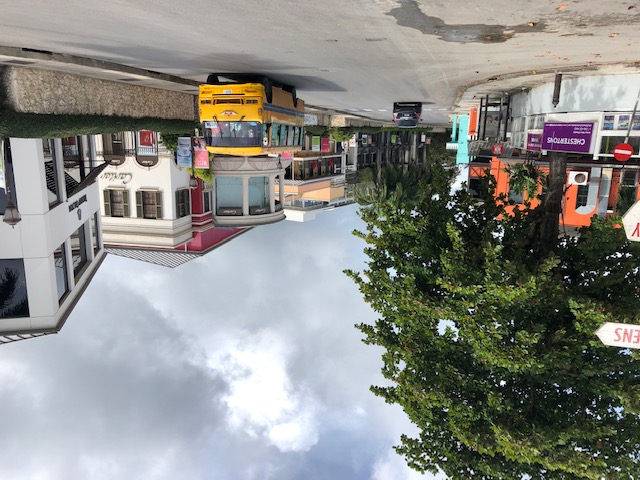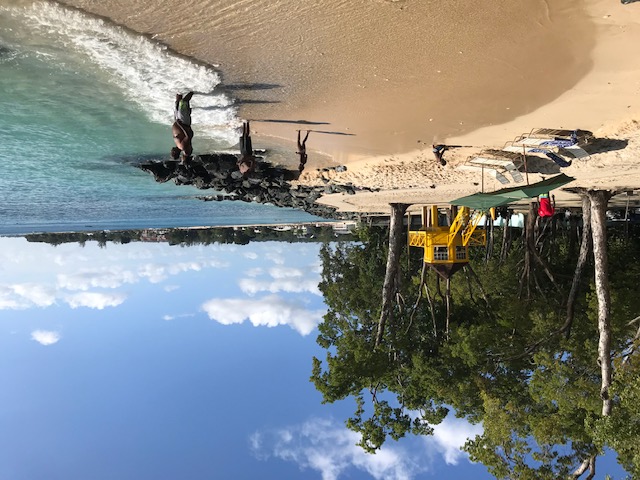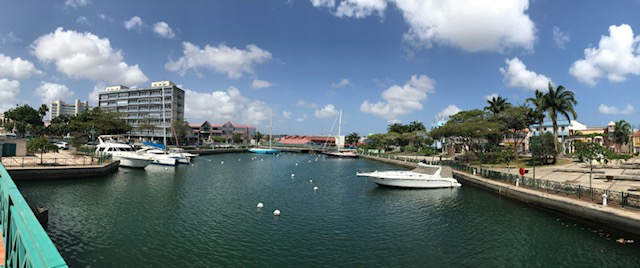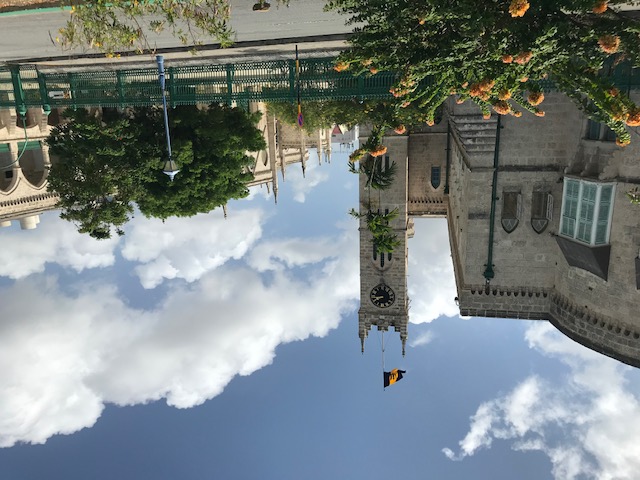Barbados: A Walk through History (Part 3)
Section 2 English Colonial Business

(Current main area of Holetow)
There is a town on the western coast of Barbados called Holetown.
Barbados, a tourism-centered country, sees large numbers of foreign visitors come through this area whose streets are lined with hotels, rental villas, restaurants, shopping malls, and other attractions.
Offshore of the current Holetown is where the English armed merchant ship “Olive Blossom” dropped anchor on May 14, 1625. The ship had been in Brazil a few weeks back and was on its way back home after finishing its business; however, the captain steered too far west and accidentally landed on Barbados.
This “accident” occurred 400 years ago played an integral part in the fate thereafter of the island of Barbados.

(Beach near Holetown. In 1625 the first English ship made landfall near this area.)
The First Settlers
The captain of the “Olive Blossom” was a man named John Powell.
Powell and his crew got wind that this was in fact the island “Barbados” that the Spanish and Portuguese occasionally dropped anchor, and just as the rumors said it was uninhabited. Abandoned villages and remnants of indigenous peoples’ daily lives were found in several places, but there were no people living on the island. Powell and his men weighed anchor and set off for home in a hurry.
Upon his return to England, Captain Powell immediately paid a visit to the sponsor of the “Olive Blossom”, Sir William Courteen, and told him about what he had seen on the island. Courteen, who was a merchant doing a wide range of business in London, probably thought “this might make a lot of money” when he heard about the uninhabited island. The next ship he sponsored was the “William and John”, with John Powell’s younger brother, Henry Powell, as the ship’s captain, headed for Barbados.
On February 17, 1627 the “William and John” landed on the same spot that the “Olive Blossom” did two years prior. However, unlike two years ago, about 80 crew disembarked as settlers and remained on the island (note 1). In order to show that the island was English property, they named their settlement “Jamestown” after the previous King of England, James I. This will later become Holetown.
This settlement that Henry Powell and the other colonists established was the starting point of the colonization of Barbados by England. Henry Powell is effectively thought to be the first colonial governor, as Courteen who was back in London, left the governance of the island up to Powell.
Beginning of Colonial Business
The first settlers that Powell brought with him cut through dense forests to open up the island while simultaneously battling the unaccustomed hot climate, food and water shortages, and malaria. The settlers fed on wild hogs that had been left on the island by the Portuguese ships, as well as yams, cassava, corn, and other crops that had been brought up from the Dutch colony Guyana in South America. The settlers were making their way from the west to the south of the island.
It took a while for colonial business to become profitable after initial investment. As Barbados was an island with no mineral resources, settlers cleared the land to make way for farms in order to grow crops which could be exported to Europe. In the beginning the main products were tobacco, ginger, indigo, and sea island cotton (note 2).
William Courteen continued to send settlers and everyday goods from England to Barbados to support Powell’s endeavors on the island. As Courteen’s treatment as patron of the island was in no way poor, the population gradually increased, with records stating that two years from the settlement of Barbados the population had reached approximately 1,800 people.
Stolen Island
However, Courteen’s colonial business would soon be snatched away by an entirely different person.
The origin of the previously mentioned Jamestown was King James I, who was originally the king of Scotland before becoming the king of England. In 1603 the last of the Tudor Dynasty, Queen Elizabeth I of England, passed away without leaving a descendant. King James VI of Scotland, who was a blood relative of the late queen, subsequently became King James I of England. This is the beginning of the Stuart Dynasty.
One of King James I’s followers was a man named James Hay, who followed the king from Scotland to London and was made an earl by James I, thus becoming Earl of Carlisle. The man who stole the rights of Barbados from William Courteen, who had been heartily investing in Barbados, was James Hay, Earl of Carlisle.
Although Hay was able to rise up the ranks to become an earl, he had a terrible spending habit and was mired in debt. In order to escape his lamentable plight, he came up with the idea of using profits from colonial business. He took full advantage of his connections within the royal family to cajole the King Charles I, son and successor of James I, to grant him the proprietorship to Barbados, stealing the island right from under Courteen’s nose. After Hay’s fraudulent-like actions, with the charter in hand declaring him the owner of Barbados, he immediately signed contracts with London businessmen leasing 10,000 acres of land on the island, and with those profits he was able to repay a part of his massive debt.
Courteen was livid, to say nonetheless, that the Earl of Carlisle had purloined the rights to the island while he wasn’t looking. Courteen petitioned to get the island back, and although he approached from various angles, it was of no use. Courteen’s connections in the royal family had all but disappeared, and so he had no choice but to give up his quest. This incident is now known as the “Great Barbados Robbery”.
I will talk about this later on, however, at this time no one was able to imagine the events that would take place in the coming years. Hay paid a bargain price for the proprietorship that Charles I granted; however approximately 20 years later Charles I was beheaded by Oliver Cromwell, who then sent navy ships to Barbados in order to subdue the unruly colonists who were no longer obeying their homeland’s rule.
“Tyrant Governor” Hawley
The Earl of Carlisle, who had seized Barbados from the hands of William Courteen, succeeded in bringing Henry Hawley, Carlisle’s confidant to the island in order to become the new governor. This was the year 1630.
The new governor Hawley was under orders from his boss, Earl of Carlisle, to make money by exporting tobacco, and other crops as much as possible, and also to raise taxes on the residents of the island so as to squeeze every penny possible from the settlers. Needless to say the reason for these orders was so that Earl of Carlisle could take a cut of the profits to pay back his debts.
Before becoming Governor of Barbados, Hawley was a textile merchant in London; his newfound position turned him into a greedy lord, subsequently acting like a “tyrant governor”. His merciless persecution against the original settlers under Courteen’s rule and extortion of taxes will be the talk of the island for years after.
Under such governance of Hawley, the ones who suffered the most were the indentured servants who were at the bottom of colonial society.
The Sorrows of the White Indentured Servants
Many people may think of the Black slaves brought from Africa as the laborers on Barbados and other Caribbean plantations, but it was not until the late 17th century and the rise of the sugar cane industry in which African slave labor became the main workforce. In fact, white European indentured servants, mainly English, Scottish, and Irish, were the main source of manual labor.
The majority of the indentured servants signed a five to seven year contract with their employer and crossed the ocean to work as manual laborers on plantations in order to escape poverty in their native country. Joining them were those who were exiled, escaped convicts, people who were literally kidnapped by human traffickers, and there are reports that even children were amongst them. These people were all from various places, but many of them were from Scotland and Ireland while the plantation managers and owners were mainly from England. Especially, a large number of the indentured servants were from Ireland which was then poor and in a subordinate position to England. (Note 3)
It is not hard to imagine the environment of these indentured servants considering the circumstances in which they arrived in. These what is called “white slaves” had to endure long hours of hard labor in exchange for poor housing and foods given to them by plantation owners. It is one story if they were working indoors doing housework, but it was hard work toiling under the burning Caribbean sun. Although it was not to the extent that the African slaves would endure later on, the indentured servants were treated horribly and their basic human rights were ignored. In the end, the burden of paying the heavy tax that Governor Hawley levied on the settlers fell on the shoulders of the indentured servants.
In 1634, the indentured servants could no longer bear their terrible circumstances and staged the first uprising that Barbados would see. Their plan was to steal the first ship they found in the harbor after attacking the plantation owners and head back to their homeland. However, they were unfortunately suppressed momentarily by the 800-person militia group that belonged to Governor Hawley.
The Downfall of Hawley
The Earl of Carlisle drained every penny he could from Barbados with the help of Hawley, but bad things don’t last forever, and in 1636 at the age of 46 and still up to his neck in debt, Hay, the Earl of Carlisle, died. His son, again James Hay, 2nd Earl of Carlisle, was still quite young and thus trustees were appointed to manage the island. This allowed Governor Hawley to do as he pleased even more than previously, and as the grip of the 2nd Carlisle and his trustees weakened, Hawley’s tyrant behavior intensified. However, word of his tyranny finally made it to the Royal Palace in London, and in 1640 Hawley was disposed of his position as Governor of Barbados, leading to his downfall. The ten-year period which Hawley held the position of governor of Barbados, his misrule and subsequent suffering of the residents left him with the reputation of being the worst governor in the island’s history.
Although Hawley led a ruthless rule over Barbados, there was one positive outcome: in 1639 he established the parliament after the residents’ discontent over his misrule had reached its peak. This was simply a measure to avert the residents’ dissatisfaction and to gain their trust; although the population of the island reached 9,000 at that time, only a handful of rich landowners were qualified to become members of the parliament. However, as I will explain further on, the existence of the third oldest parliament amongst English colonies (note 4) will be of no small influence on Barbados’ forthcoming history.
The Origins of Bridgetown
In the beginning when Barbados became a British colony, the center of the island was Jamestown, later Holetown, which Henry Powell and his settlers made their starting point on the west coast. However, as the island became further settled the center of activity moved southward towards the area near a large bay.
The village facing the bay at the mouth of the island’s largest river (currently named Constitution River) will gradually become the main settlement on the island, and will develop into the political and commercial center. This is the beginning of Barbados’ current capital, Bridgetown. A port was built on the north side of the bay, which was used during the colonial area to load sugar and take in boats carrying slaves; today it is the Port of Bridgetown, used to dock multiple large cruise ships sailing around the Caribbean Sea.

(The Constitution River, which flows through the city of Bridgetown)
This bay which embraces Bridgetown is called Carlisle Bay, named during the rule of the notorious Governor Hawley, named after his boss, the first Earl of Carlisle.
Barbados saw initial investment right from the start of its colonization by Sir William Courteen, and whose rights to the island were stolen by the Earl of Carlisle. What irony it is that the bay which currently holds Barbados’ most important infrastructure-political, economical, tourism-wise, and security-wise, should be named after a swindler who climbed the social ladder to earn a place in the English aristocracy.
(To be continued in Part 3 “The Island Tossed About by the English Civil War”)

(The Barbados Parliament building. The current building was constructed in the 1870s)
(Note 2) Sea Island Cotton is a high quality cotton made from raw cotton found on the West Indies islands, which was cultivated by the indigenous people before the arrival of the Europeans. When sugar production became the main industry later on, sea island cotton production would become obsolete. Today, Barbados still continues to produce only a minuscule amount of sea island cotton, of which tiny amounts are exported to Europe for a high price. I had the chance to visit a cotton processing plant and felt the final product, which surprised me at its luster and smoothness to the touch.
(Note 3) With these circumstances in the background, the former white society of Barbados had a tendency to look down upon those with Scottish and Irish backgrounds, which persisted for quite some time. For example, starting with the establishment of the Barbados Yacht Club (mentioned in the beginning of my first column) in 1924, men who were of Scottish or Irish background who were regarded to have indentured servants in their ancestry were not granted membership; needless to say any person of color was denied acceptance to the club as well (according to the Club’s August 2020 bulletin).
(Note 4) Virginia and Bermuda were the two British colonies which established parliaments before Barbados. The parliament established by Governor Hawley underwent many transitions to eventually become Barbados’ House of Assembly of today.
(This column reflects the personal opinions of the author and not the opinions of the Ministry of Foreign Affairs of Japan)
WHAT'S NEW
- 2025.1.12 UPDATE
PROJECTS
"Barbados A Walk Through History Part 15"
- 2024.12.4 UPDATE
PROJECTS
"Barbados A Walk Through History Part 14"
- 2024.9.17 UPDATE
PROJECTS
"Barbados A Walk Through History Part 13"
- 2024.7.30 UPDATE
EVENTS
"408th Lecture Meeting Regarding Global Issues"
- 2024.7.23 UPDATE
PROJECTS
"Barbados A Walk Through History Part 12"
- 2024.7.9 UPDATE
ABOUT
"GREETINGS FROM THE PRESIDENT JULY 2024"
- 2024.7.4 UPDATE
EVENTS
"APIC Supports 2024 Japanese Speech Contest in Jamaica"
- 2024.6.27 UPDATE
EVENTS
"407th Lecture Meeting Regarding Global Issues"
- 2024.5.21 UPDATE
EVENTS
"406th Lecture Meeting Regarding Global Issues"
- 2024.5.14 UPDATE
EVENTS
"405th Lecture Meeting Regarding Global Issues"




